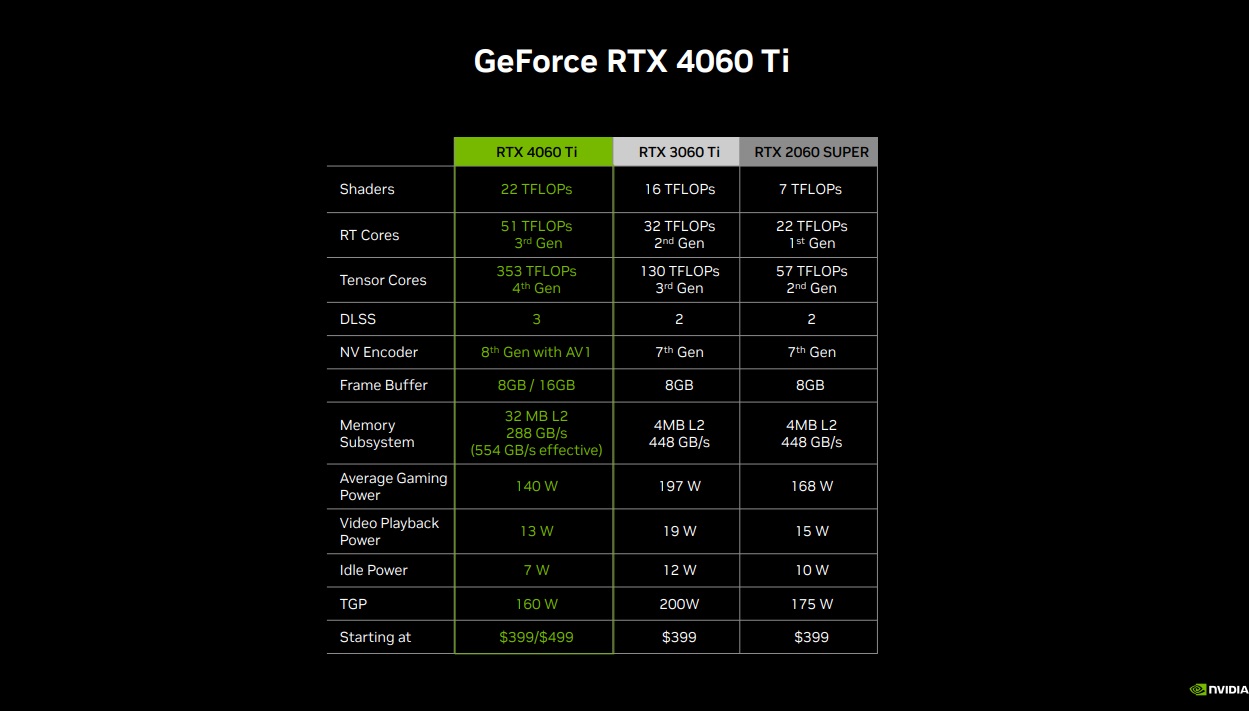
NVIDIA has presented in society its new GeForce RTX 4060 and GeForce RTX 4060 Ti, two graphics cards with which the green giant covers the mid-range and medium-high range, respectively, and which have all the improvements introduced by architecture Ada Lovelace at the level of performance, efficiency, ray tracing and artificial intelligence applied to gaming. In this sense, it stands out, how could it be otherwise, the support of DLSS 3 (frame generation).
The GeForce RTX 4060 It is designed to play optimally in 1080p resolution, and it is emerging as a very interesting renewal aimed at the general public, both for price and for benefits. In this regard, it is important to note that, according to data from the classic Steam hardware and software survey, 77% of users play in 1080p, and four of the five most popular GPUs on that platform are from the NVIDIA 60 series. .
NVIDIA has not confirmed the full specifications of the GeForce RTX 4060, but as you can see in the attached image we have a lot of information in this regard. Said graphics card will have a power of 15 TFLOPs in FP32, 35 TFLOPs in ray tracing and 242 TFLOPs at the AI level. Compared to the GeForce RTX 3060 we see a modest jump in FP32, but a very big advance in ray tracing and AI.
With the GeForce RTX 4060 we will have AV1 support with the 8th generation NV Encoderwe will enjoy the value that DLSS 3 represents both in games and in professional applications and tools, and we will have 8 GB of graphics memory, enough to get a totally optimal experience playing in 1080p with maximum quality, or in 1440p adjusted for quality consumption. memory and the requirements of each degree.
The GeForce RTX 4060 is more powerful and more advanced than the GeForce RTX 3060, but it is also much more efficient. Take a look at the consumption values, the former registers an average of only 110 watts, which means that it could work without problems with a single additional 6-pin power connector, while the latter has an average consumption of 170 watts. The difference in terms of efficiency is hugeeven without bringing DLSS 3 into the equation.
New larger L2 cache: everything you need to know
The memory bus that this graphics card will have will be 128 bits, which leaves us with a bandwidth of 272 GB/s. To compensate for this reduction in bandwidth NVIDIA has increased the L2 cache to 24 MB, that is, we have 700% more L2 cache compared to the GeForce RTX 3060, and it achieves a bandwidth of 453 GB/s.

L2 cache in Ampere.
In the case of the GeForce RTX 4060 Ti we also have a 128-bit bus and a bandwidth of 288 GB/s, but it has a 32 MB L2 cache that increases the bandwidth up to 556GB/s. In total we have 8 times more L2 cache than in the previous generation.
The cache plays a very important role. In this case we are talking about L2 cache, a type of memory that is faster than L3 cache, and that is located closer to the GPU, which greatly reduces latency. Thanks to this cache, the maximum bandwidth achieved by the GeForce RTX 4060 and GeForce RTX 4060 Ti is greatly increased, by increasing the total amount available NVIDIA has achieved improve performance despite using a smaller memory bus.
When the GPU needs find data or instructions to complete their work cycles it resorts to the L2 cache first. He does this because is what is closest to you (less latency) and what you can communicate with faster. This generates a request for data that can be resolved with a hit or a failure, depending on whether or not what you need is in the cache. If found is a hit, and said call is terminated, if not, a call is made to the graphics memory.

L2 cache on Ada Lovelace. More amount means higher hit rate, and reduces calls to graphics memory.
If we have a very small L2 cache the amount of data and instructions that we can store in it will be very limited, which will mean that in the end we have higher failure rate in those data requests, and that the dependence on the memory bus and graphics memory increases.

Here we can see more clearly represented how the requests to the graphic memory are reduced thanks to the larger L2 cache.
With Ada Lovelace NVIDIA has vastly increased the amount of available L2 cache, and this makes the hit rate higher and reduces the dependency on the data bus and graphic memory. That is why it has been possible to reduce the buses to 128 bits without sacrificing performance.
GeForce RTX 4060 Specs and Performance
This new graphics card is 20% more powerful than the GeForce RTX 3060 and consumes almost 36% less. If we take DLSS 3 into account, the improvement in favor of the GeForce RTX 4060 is 70%, and obviously this does not affect consumption in any way. Compared to the GeForce RTX 2060 the difference is even bigger, since we are talking about 60% improvement without DLSS 3 and 230% with this technology activated.
In the attached graphs we can see performance data perfectly broken down, including both FPS averages and minimums (1% low). The improvement we get with the GeForce RTX 4060 is impressive in many cases, though Microsoft Flight Simulator stands out without a doubt, where we have a gain of more than 60 FPS in minimum, and almost double in the average FPS rate, since we went from less than 80 FPS with a GeForce RTX 3060 to more than 160 FPS with the GeForce RTX 4060 thanks to DLSS 3 .
Remember that the minimum FPS rate is important because it influences the real fluidity that we are going to notice when running a game. If the minimum rate is very low we will notice a stuttering (image stutter) very marked, and the experience will not be good even if the average is well above 60 frames per second.
GeForce RTX 4060 Specs (Estimated)
- AD107 graphics core in 5nm.
- 3,072 shaders at 2.5 GHz.
- 96 texturing units.
- 32 raster units.
- 96 fourth generation tensor cores.
- 24 third generation RT cores.
- 128-bit memory bus.
- 8 GB of GDDR6 with a bandwidth of 272 GB/s.
- 15 TFLOPs of power in FP32.
- 24 MB L2 cache (453 GB/s effective).
- 115 watt TGP, average consumption 110 watts.
Price and release date
The GeForce RTX 4060 will arrive in July. Its price will be 335 euroVAT included. Prices in dollars do not include taxes, always keep this in mind when you compare equivalences of dollars to euros.
GeForce RTX 4060 Ti Specs and Performance
The GeForce RTX 4060 Ti represents a clear leap over the GeForce RTX 3060 Ti, both in gross power and in consumption. As we can see in the attached table, the new from NVIDIA has a power of 22 TFLOPs in FP32, 51 TFLOPs in ray tracing and 353 TFLOPs in AI, while the GeForce RTX 3060 Ti has 16 TFLOPs, 32 TFLOPs and 130 TFLOPs , respectively.
This new graphics card opens the doors to all the improvements that Ada Lovelace has introduced, and also represents a remarkable evolution in terms of efficiency, since it renders up to 15% more than GeForce RTX 3060 Ti without DLSS 3 and up to 70% more with DLSS 3. At the consumer level, the GeForce RTX 4060 Ti registers an average of 140 wattswhile the GeForce RTX 3060 Ti consumes 197 watts.
The two attached graphs show us the comparative performance offered by the GeForce RTX 4060 Ti in both its 8 GB and 16 GB versions, and it is obvious that with the second we will enjoy better performance in some titles, and we will also be able to activate higher graphic quality settings. It can be a good investment in the future, that is clear, and it is also emerging as a more interesting option for those who want to use it to play and work.
Compared to the GeForce RTX 3060 Ti we see that, thanks to DLSS 3, the GeForce RTX 4060 Ti is capable of double the FPS rate in some titles, Like Microsoft Flight Simulator. Without this technology, the improvement is more modest, but it is clearly appreciated, and the leap that NVIDIA has taken with this new graphics card in terms of efficiency it is excellent.
GeForce RTX 4006 Ti Specs (Estimated)
- AD106 graphics core in 5nm.
- 4,352 shaders at 2,310 MHz-2,535 MHz, normal and turbo mode.
- 128 texturing units.
- 128 fourth generation tensor cores.
- 64 raster units.
- 32 3rd generation RT cores.
- 128-bit bus.
- 8GB-16GB of 18GHz GDDR6 (288GB/s bandwidth).
- 22 TFLOPs of power in FP32.
- 32 MB L2 cache (554 GB/s effective).
- 160 watt TGP, average consumption 140 watts.
Price and release date
The 8 GB GeForce RTX 4060 Ti will hit the market on May 24 with a price of 449 euro, and the 16 GB version will be available from July with a price of 559 euro, VAT included. As I have already told you, prices in dollars do not include taxes.















